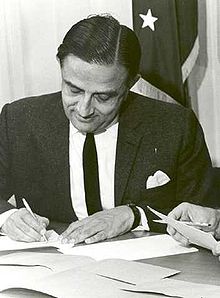This article needs to be updated. (April 2020) |

After independence, Jawaharlal Nehru, the first prime minister of India, initiated reforms to promote higher education and science and technology in India.[2] The Indian Institute of Technology (IIT)—conceived by a 22-member committee of scholars and entrepreneurs in order to promote technical education—was inaugurated on 18 August 1951 at Kharagpur in West Bengal by the minister of education Maulana Abul Kalam Azad.[3] More IITs were soon opened in Bombay, Madras, Kanpur and Delhi as well in the late 1950s and early 1960s along with the regional RECs (now National Institutes of Technology (NIT). Beginning in the 1960s, close ties with the Soviet Union enabled the Indian Space Research Organisation to rapidly develop the Indian space program and advance nuclear power in India even after the first nuclear test explosion by India on 18 May 1974 at Pokhran.
India accounts for about 10% of all expenditure on research and development in Asia and the number of scientific publications grew by 45% over the five years to 2007. However, according to former Indian science and technology minister Kapil Sibal, India is lagging in science and technology compared to developed countries.[4] India has only 140 researchers per 1,000,000 population, compared to 4,651 in the United States.[4] India invested US$3.7 billion in science and technology in 2002–2003.[5] For comparison, China invested about four times more than India, while the United States invested approximately 75 times more than India on science and technology.[5]
While India has increased its output of scientific papers fourfold between 2000 and 2015 overtaking Russia and France in absolute number of papers per year, that rate has been exceeded by China and Brazil; Indian papers generate fewer cites than average, and relative to its population it has few scientists.[6]
India is ranked 40th in the Global Innovation Index in 2023.[7]
- ^ Burleson, D. (2008). Space Programs Outside the United States: All Exploration and Research Efforts, Country by Country. McFarland. 136. ISBN 0-7864-1852-4
- ^ Cite error: The named reference
nandawas invoked but never defined (see the help page). - ^ Cite error: The named reference
vratwas invoked but never defined (see the help page). - ^ a b "India lagging behind in S&Tt: Govt". 17 February 2009.
- ^ a b "India lagging in science and technology, says official". scidev.net. 29 August 2006.
- ^ Van Noorden, Richard (2015). "India by the numbers". Nature. 521 (7551): 142–143. Bibcode:2015Natur.521..142V. doi:10.1038/521142a. PMID 25971491. S2CID 4444175.
- ^ Dutta, Soumitra; Lanvin, Bruno; Wunsch-Vincent, Sacha; León, Lorena Rivera; World Intellectual Property Organization (13 November 2023). Global Innovation Index 2023, 15th Edition. World Intellectual Property Organization. doi:10.34667/tind.46596. ISBN 9789280534320. Retrieved 28 October 2023.
